11 PPC Advertising Strategies Every Agency’s Campaigns Need

Do you have that one friend who’s convinced that advertisers listen in on their conversations through “special” devices?
As hilarious as it sounds, that’s how some people think advertising campaigns work (with eavesdroppers)
But no, that’s not how advertising really works…
Pay per click (PCP) is a digital marketing solution in which an advertiser like you pays a publisher like Google, Facebook, etc. for each time one of your ads is clicked on.
But for some agencies, clicks just don’t convert.
And that’s where effective PPC advertising strategies come in….
PPC ads have the potential to raise awareness and convert leads into paying customers.
That’s why it’s so vital to try and squeeze as much out of your PPC ads as possible.
And you might be already following some PPC advertising strategies for your own agency or for your clients. But with today’s resource, you’ll learn:
- The 11 PPC advertising strategies that you need to model to start seeing leads rise.
- Why these strategies work—and how you can easily implement each of them.
- And the best ways you can maximize the value of your PPC ads.
But for now, let’s review the concept of…

What is a PPC Advertising Campaign?
PPC, short for “pay per click,” is a digital marketing solution in which an advertiser pays a publisher (Google, Facebook, etc.) for each time an ad is clicked on.
Although Google Ads and Facebook are the most popular platforms for PPC campaigns, it’s possible on other platforms like Instagram, Bing, and Twitter.
On average, businesses earn $2 for every $1 they spend on Google ads. That’s according to WordLead.
In total, businesses spent $41.43 billion on Facebook ads in 2020, says eMarketer.
And considering Statista states that there are 4.66 billion people active using the internet, PPC ads are bound to make a sale or two for you and your clients.

To be clear, your total ad ranks on search and social are determined by quality scores. And your bid amounts and the reception from the audience play a key role in determining your ad rank.
An ad rank is also dependent on how you compare with ads targeting similar audiences.
The higher your ad rank, the more people will see it.
And the more people see it, the more conversions for you and your client.
Although there’s a lot of moving parts to PPC advertising, it’s important that you learn some strategies that work.
That way, you generate more sales.
#1 PPC Advertising Strategy to Model: Choose the Right Keywords
Before you start any PPC campaign, you must try to think of what questions your target audience would ask.
Because user intent is critical in determining the right keywords you use.
Are you targeting top-of-the-funnel customers or bottom-of-the funnel customers?
For the top of the funnel, you would want to use keywords that align with general questions.
Such as “How do I start a business?”
And bottom-of-the-funnel questions will be more like, “Apply for business loan.”
Additionally, ensure that your PPC ad is connected to a specific landing page. Use the same keywords for PPC ads as the pages you want people to go to.
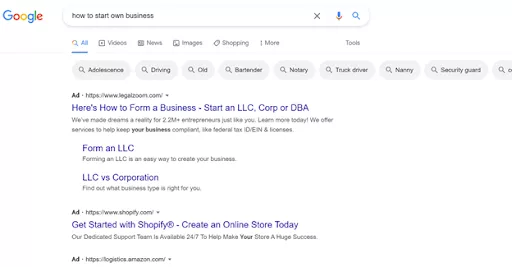
Now, to get an even better sense of what keywords you should be using in PPC ads, consider keyword search tools like Google Trends, Soovle, and Moz.
Find common pain points. Learn from your competitors.
One way to narrow down who clicks on your ads is with long-tail keywords.
According to OuterBox, 50% of searches use 4 words or more.
Long-tail keywords are longer and yield more specific search queries.
As a result, you’ll be lowering the cost per click (CPC) because long-tail keywords are less competitive, and the customer has more intent.

Keyword research is critical for a myriad of reasons including:
- Helping your PPC ads get seen by relevant audiences
- Leading to higher conversion rates
- Allowing you to prioritize time
- Providing guidance on advertising budget allocation
- Building greater awareness in the local realm

For the next strategy, let’s talk about FOMO.
#2 PPC Advertising Strategy to Model: Create a Fear of Missing Out (FOMO)
The term “peripheral route persuasion” in advertising is when feelings or attitudes are formed or altered due to emotional cues.
There’s no rationality behind it.
Coca-Cola does it all the time. They make you associate “good times” with the brand.
But fear is perhaps the most powerful emotion of all.
And sometimes it makes us buy things.
Apple is considered the master of innovation. They are so good at it that they even built upon the concept of FOMO.
When you’re in a group chat and don’t own an iPhone, your text lights up green, as opposed to everyone else’s blue.
It’s like a giant sign that says, “I’m not that cool.”
Now, that’s a childish mindset to have. But I’m sure it’s incredibly effective on teens and young adults.
You feel kind of ostracized.
So to solve that distress, you purchase an iPhone even though an Android is a perfectly fine device.

FOMO has long been used by advertisers because it works.
There are deep psychological roots that are beyond the scope of this article.
According to research by Evenbrite, nearly 7 out of 10 millennials experience FOMO on social media platforms.
In all, over half of all social media users experience it.
According to a study carried out by PR firm Citizen Relations on Canadian millennials, losing social status is a key component to FOMO.
To put it simply, they want to appear to be “in the know.”

Some of the ways to use FOMO in your PPC strategies are the following:
- Make it known that “everyone” is buying your product or service
- Use time sensitivity for the ad
- Offer incentives for making a decision quickly
- Show how many items are in stock
- Turn it into a contest with other consumers (e.g. “30 other people are viewing this flight”)
- Invoke emotion with imagery
Below is a good example of a TV-selling company that incorporates FOMO into its PPC ad strategy.

If you’re wondering what the best social media platform to use FOMO is, you probably already guessed it. Facebook.
Nearly three out of four Facebook users experience FOMO. And there isn’t even a close second.

#3 PPC Advertising Strategy to Model: Don’t Forget About Negative Keywords
On average, CPC across all industries using search is $2.39, according to WordStream.
That goes all the way down to $0.41 on display ads.
So there’s a wide range of confidence levels when implementing your PPC ad strategy.
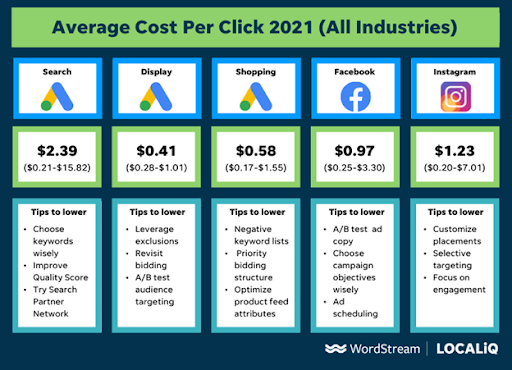
But there are ways to cut the cost down.
Negative keywords are a strategy where you try to weed out potential clicks by preventing your PPC ad from being seen by people searching certain words.
For example, if your client sells men’s sunglasses, then you’d want to use the negative keywords “women’s sunglasses” or “kid’s sunglasses”.
In doing so, you keep low-quality clickers from clicking on your advertisement.
Factoring in negative keywords for your PPC ad strategy narrows down who sees your ad. Therefore, CPC goes down too.
Remember, not every PPC ad necessarily requires negative keywords.
Use negative keywords when:
- PPC advertising campaign CTR (click-through rate) is not hitting your targets
- People who click are not converting enough
If your CTR is low, it’s because the wrong people are seeing it.
And when conversion rates are not satisfactory, it might indicate your ad copy does not match up with what the person expected to see.
Simply adding negative keywords helps you focus on a more defined target audience.
As a suggestion, use a spreadsheet that lists all the potentially beneficial negative keywords to use in your client’s PPC ads. That way, anyone on your team has access to the list to experiment with.
By the way, you should already be doing that with normal keywords.
#4 PPC Advertising Strategy to Model: Defined Targeting Should Become a Habit
With so many people across the web, your PPC ads often get seen (and rejected) by so many people outside your target audience.
Luckily, Google Ads allows you to target by age and gender.
Once upon a time, WordStream had a client in the retirement-planning industry.
Her problem? She had too many (relatively) young people coming to her website while she was more interested in older folks that invest more.
By targeting people of ages 45+, her advertiser costs were cut down significantly.
Use hard data and research studies you come across to discover what demographics you should consider in your PPC ad strategy.
Sometimes, the results don’t align with your assumptions.

Keep in mind that PPC ad targeting isn’t limited to just demographics.
While Google Ads is limited in targeting options, social media platforms like Facebook and Instagram allow psychographic and behavioral targeting.
For example, let’s say your agency helps a client sell a keyword search tool.
You can use ad filtering that ensures the ad is seen by people following marketing accounts or are interested in SEO.
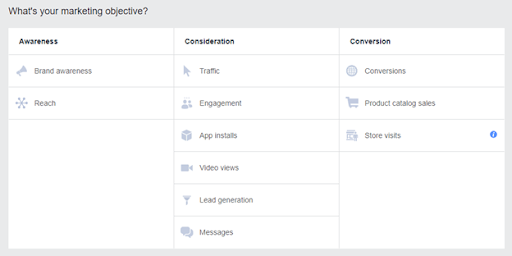
Basically, ad filtering is just another way to optimize your overall PPC ad strategy.
Now that defined targeting is out of the way, let’s discuss our next PPC strategy.
#5 PPC Advertising Strategy to Model: Produce Effective Ad Groups
Ad groups are sort of confusing when you first get into them.
At least it was for me.
But once you grasp it, you realize it’s rather simple.
Google offers you the chance to build groups of topic clusters.
An effective ad group ensures that your ads are being seen and clicked on by the right people.
And you give your client a better chance to sell his or her goods.
For example, imagine that your client sells beachwear. You’ll want to have one or more ads correlating with specific keywords and accompanying landing pages.
One campaign will target men and the other target women.
Men might have two ad groups labeled “summer shirts” and “golf shorts.”
While women will have groups named “bathing suits” and “sandals.”
But each subgroup will have its own keywords that correlate with them. That way, the ads lead to landing pages that accurately correspond to user intent.
Below is an illustration of what an automobile dealer might do in a PPC advertising campaign.
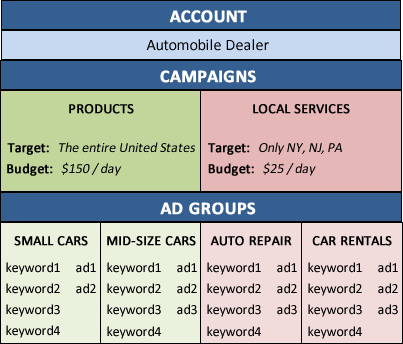
This automobile dealer created a hierarchy that will optimize PPC ad spend.
#6 PPC Advertising Strategy to Model: Optimize Your Ads for Mobile
So you’ve heard the word “optimize” a lot because it’s the foundation to effective advertising solutions.
There’re so many things to optimize.
But never neglect mobile optimization though.
According to Statista, over half of all website traffic stems from mobile devices.
And research from OuterBox shows that 40% of consumers will ditch a brand and go to a competitor if their mobile experience was lackluster.
It’s easy to see that mobile optimization is a critical component of a successful PPC advertising campaign.
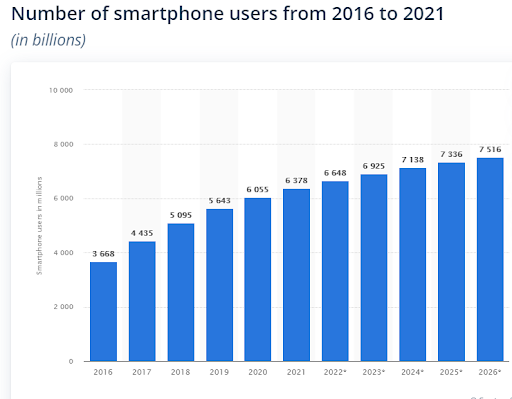
How can you make sure that your PPC strategy is mobile friendly?
First thing’s first.
Make sure that the landing pages are mobile friendly. Your client’s potential customers don’t want to end up on a page where the text is cut off.
Have you ever tried reading a blog that isn’t mobile friendly?
If you did, it probably wasn’t for very long.
Either the copy gets cut off or the accessibility is abysmal. You’re forced to squint your eyes to read the words. Either way, I’m sure you gave up quickly.
Your PPC ad copy and keywords can be the best thing since sliced bread, but if the page they land on isn’t easy on their eyes, that bounce rate is going to be high.

Over on Facebook, you can specifically target mobile users. This is useful when you notice most of your page traffic comes from mobile users.
On Facebook, there are News Feed ads, Messenger ads, Stories ads, and more.
Also, there are unique things you can do like incorporating PPC ads that ask consumers to share contact info on Messenger, creating new leads in a personalized manner.
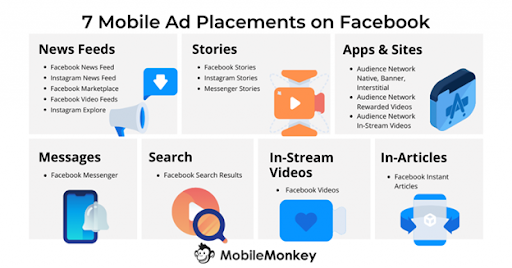
And Instagram is another social media platform to be mindful of in your PPC ad strategy.
Since most of the user base is interacting with mobile devices, it makes sense to make Instagram PPC ads mobile-first.
With the mobile-first PPC advertising strategy, you’ll be prepared to appease the mobile crowd.
You know, the crowd who makes 53% of all online sales, according to SaleCycle.
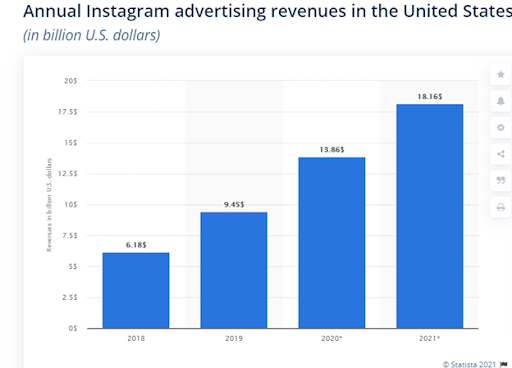
Let’s move on to our next PPC strategy.
#7 PPC Advertising Strategy to Model: Create Lookalike and Similar Audiences
Back in 2013, Facebook came up with Lookalike Audiences. And it’s been a godsend ever since.
Google came along with its own version called Similar Audience.
With these integrations, Facebook and Google can compile huge amounts of data on their users for ad-targeting purposes.
When you use a lookalike audience feature, Facebook or Google will start targeting other users with similar interests, shopping preferences, and demographics as your original target audience.
In turn, it allows you to cast a wider net on prospects while not casting too far out.
Google, Facebook, Instagram, LinkedIn, or whatever platforms your clients are using will start showing you PPC advertisements to this new audience.
Isn’t AI a beautiful thing?
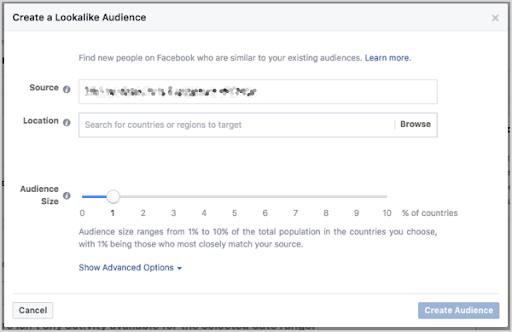
As per Growth Cave, one e-commerce store achieved a nearly 455% increase in ROI simply by using a better lookalike audience.
What they did was focus on creating a lookalike audience based on their most profitable customers instead of their general customers.
And Marketing 360 says that a client of theirs selling sports and health supplements generated over $3,800 on a $575 Facebook lookalike audience budget. And a 21% conversion rate!
Furthermore, Google claims a Prague-based clothing retailer used Similar Audiences and saw that 63% of its traffic came from new users.
It makes sense to target new audiences similar to your target audience.
Because human nature is not so black and white. Just because a marketing professional isn’t in the same target audience as a health professional doesn’t mean they don’t overlap.
Oftentimes, you might find that marketing professionals and doctors have the same hobbies, such as golf or going to the beach (depending on locale).
There are many intersections of personas in the consumer market.
Some tips to keep in mind…
- Detect common ground between your original audience and a lookalike audience.
- Use multiple lookalike audiences based on narrowly defined segments.
- Closer to original audience = better success rate.
- For higher populated regions, target 1%.
- Adjust your lookalike audience PPC ad bids depending on performance.
- Customize an audience based on social media engagements.
- Create custom audiences for leads, not just for the highest-paying customers.
#8 PPC Advertising Strategy to Model: Verify That Your Landing Pages Are Up to Snuff
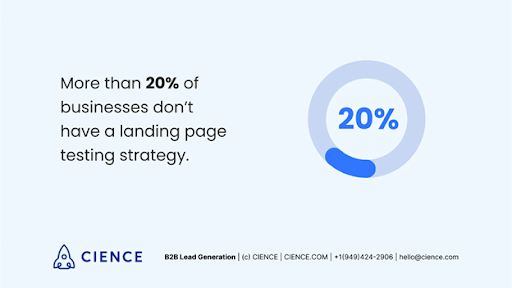
Have you ever clicked on an ad that you thought would lead to an awesome site?
Then once you were brought to the landing page, you realized that you wanted out?
It happens though.
Sometimes the ad copy doesn’t match up with your expectations.
According to CXL, bounce rates for paid search are over 44%.
And up to nearly 56% for display ads.

So how can you improve your bounce rates?
For one thing, let’s look at mobile optimization again. According to CXL, mobile users are the most likely to leave your landing page after clicking on an ad.
This indicates that mobile users are pickier, or your landing page(s) is not mobile friendly.
Now get on that.
Next, check your keyword strategy.
Are the keywords for your landing page being used in your PPC ads too? Similar words and phrases? How about negative keywords?
If your keywords already match up, then maybe it’s time to try some new ones.
Another thing to factor in with landing pages is making sure that there are no distractions.
What do I mean?
For one thing, make sure the landing page is as straight to the point as possible. And don’t even bother with a navigation panel on landing pages.
Have plenty of white space.
Below is a perfect example of a best-in-class landing page.
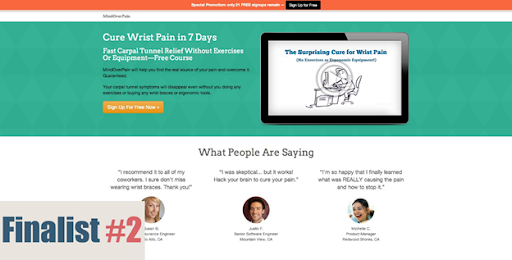
You see, it’s clean and crisp.
And the use of color draws your eyes on the CTA.
Your landing page should include:
- Persuasive copy
- A headline that aligns with your PPC ad
- An obvious CTA near the top of the page
- Keywords that match the product or service the PPC ad promotes
- Social proof, when applicable
- Use of images or video that might provide value to the visitor
#9 PPC Advertising Strategy to Model: Take Advantage of Google Reviews
According to Bizrate Insights, 54.7% of consumers consult at least four reviews before making a purchasing decision.
Social proof is needed everywhere in marketing. A good reputation removes buyer uncertainty.
Equally important, a high review score or rating is the most important factor to consumer buying decisions.
In fact, it’s the leading factor in purchasing decisions, according to Bizrate Insights.
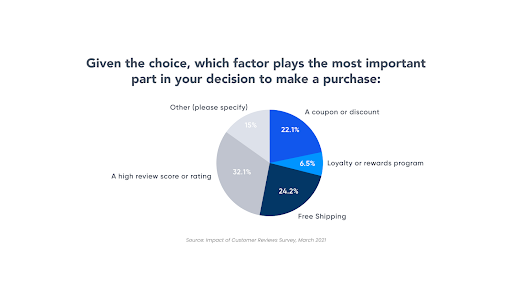
If utilizing reviews isn’t already part of your PPC advertising campaigns, then you’re doing it wrong.
To take it further, Google says PPC ads with seller rating extensions get a 17% higher CTR than ads without them.
And you can easily set up a review extension. But your submission must be approved first.
Either Google will have to review your site and give it the approval or your company must receive enough unique reviews from consumers in a country within 12 months (usually at least 100 reviews).
In addition to that, your text ads need to average out to at least 3.5 stars and your visible url domain must match the domain that Google has for your business.
Using reviews in your agency’s PPC advertising campaign is especially useful if your client is a local business.
According to BrightLocal, 5-star ratings earn businesses 39% more clicks from Google Local than 1-star ratings.
Moreover, jumping up from a 3-star to 5-star rating lands businesses 25% more clicks on Google Local Pack.
And reviews for your PPC ads don’t stop at the search level.
With the help of software developer Yotpo, Facebook ads can integrate reviews too.
In five months, retailers using review-based ads saw a 4x higher CTR and 50% reduction in cost per ad (CPA) and CPC.
Pretty nifty, huh?
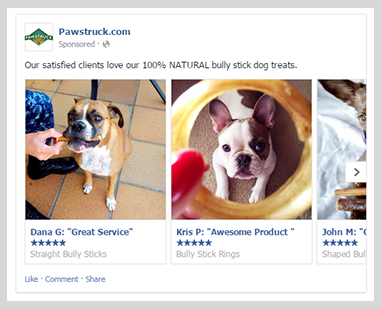
#10 PPC Advertising Strategy to Model: Dynamic Keyword Insertion (DKI) Adds Personalization
Have you heard of dynamic keyword insertion?
It sounds kind of fancy.
And it is fancy.
DKI is PPC on God Mode.
By nature, it’s malleable in that it changes ad copy to match a search request.
As a result, you’re adding personalization to the customer touchpoint.
Considering that research from Epsilon shows that 80% of shoppers are more likely to buy from a company that offers personalized experiences, it’s probably not a bad route to go.
With DKI, you have a set of keyword search queries that you think your target audience would type in the search bar.
Each keyword variant is closely related, and they lead to the same landing page.
But the trick is, if the person doesn’t type an exact match, they will see the same PPC ad but with an ad copy that is relevant to the search query.
Essentially, DKI creates substitute ad copy that will better match user intent.
So say your client sells air conditioners.The ad keyword code is probably just “air conditioner”
With DKI, you can add related keywords that will replace the generic ad copy that reads “air conditioner” when someone uses those related keywords.
You might have related keywords “affordable air conditioner” or “small air conditioner”. Now, when someone types in those similar search queries, the ad will read “affordable air conditioner.”
Or “small air conditioner” depending on their query.
Luckily, Google has been kind enough to provide an example that puts my explanation to shame. But keep in mind that you can also use DKI on other platforms like Facebook and Bing.
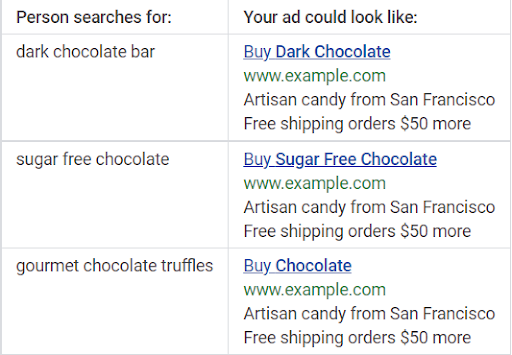
DKI is another PPC advertising strategy that aims to save money by creating ads that are as closely matched with search queries as possible.
Some precautions with DKI:
- Don’t use long-tail keywords (they may exceed the ads character limit)
- Avoid broad match keywords at all costs (could be irrelevant)
- Steer clear of misspelling of words (they will appear verbatim in the PPC ad)
#11 PPC Advertising Strategy to Model: Track In-Store Conversions
“My CPU is a neural-net processor, a learning computer. The more contact I have with humans, the more I learn.”
— The Terminator
If Arnie’s Terminator taught us anything, it’s that machine learning can be both good and bad.
But in your case, it’s good.
Do you have a client that sells products or services in physical locations?
If so, one of your PPC advertising campaign strategies ought to be Store Visit Conversion tracking in Google Ads.
Google’s advanced, almost-futuristic technology pulls all sorts of data such as geo-tracking of Google accounts and historical sales aggregate models to estimate the conversion rate of your PPC ads for physical sales.
To use Store Visit Conversion, the following must be met:
- You are in an eligible country
- Your ads are using location extensions
- Your ad performance meets Google’s threshold
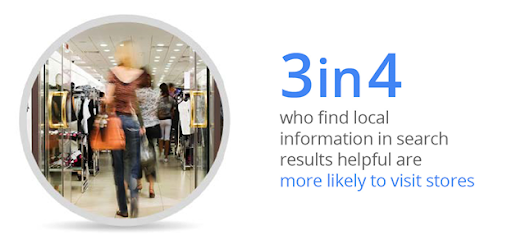
A lot of people see your ads and don’t click on them.
But they may very well have found your ad to be helpful.
Then they could visit a physical location later on.
Not only that, Think with Google states that 42% of in-store shoppers conduct online research while they are in the stores.
That’s why big companies like Nike and Sprint are conducting studies on in-store mobile behavior.
When gauging the performance of a PPC campaign, you must look at it from multiple angles.
If your client has physical locations for customers to make a purchase, make sure that Store Visit Conversion is part of your growing list of PPC advertising strategies.
Conclusion
This resource covered some of the best ways you can maximize the value of your PPC ads.
Whether you need to reach out on social media or on search engines, these strategies will make sure your ads are being seen by the right people at the right place.
Once you get used to making these strategies a habit, your clients will have to make a habit of seeing higher ROIs.
At AutoGrow, we’ve been delivering high ROIs for clients and agencies for 11 years. If your team needs a hand in its PPC campaigns, don’t hesitate to reach out to us.
Have you already been using some of these strategies?
Learn anything new?
Let me know in the comments below.
Keep AutoGrowin’, stay focused.
Mark

















